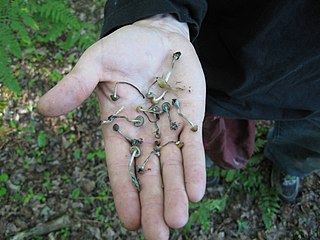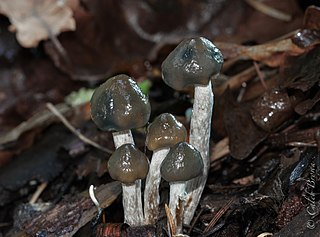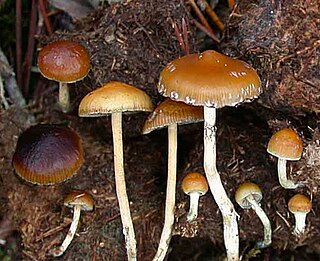
Psilocybe cubensis is a species of psychedelic mushroom whose principal active compounds are psilocybin and psilocin. Commonly called shrooms, magic mushrooms, golden tops, cubes, or gold caps, it belongs to the fungus family Hymenogastraceae and was previously known as Stropharia cubensis. It is the most well known psilocybin mushroom due to its wide distribution and ease of cultivation.

Psilocybe cyanescens is a species of potent psychedelic mushroom. The main compounds responsible for its psychedelic effects are psilocybin and psilocin. It belongs to the family Hymenogastraceae. A formal description of the species was published by Elsie Wakefield in 1946 in the Transactions of the British Mycological Society, based on a specimen she had recently collected at Kew Gardens. She had begun collecting the species as early as 1910. The mushroom is not generally regarded as being physically dangerous to adults. Since all the psychoactive compounds in P. cyanescens are water-soluble, the fruiting bodies can be rendered non-psychoactive through parboiling, allowing their culinary use. However, since most people find them overly bitter and they are too small to have great nutritive value, this is not frequently done.

Psilocybe tampanensis is a very rare psychedelic mushroom in the family Hymenogastraceae. Originally collected in the wild in a sandy meadow near Tampa, Florida in 1977, the fungus has never again been reported in Florida, but was later collected in Mississippi. The original Florida specimen was cloned, and descendants remain in wide circulation. The fruit bodies (mushrooms) produced by the fungus are yellowish-brown in color with convex to conic caps up to 2.4 cm (0.9 in) in diameter atop a thin stem up to 6 cm (2.4 in) long. Psilocybe tampanensis forms psychoactive truffle-like sclerotia that are known and sold under the nickname "philosopher's stones". The fruit bodies and sclerotia are consumed by some for recreational or entheogenic purposes. In nature, sclerotia are produced by the fungus as a rare form of protection from wildfires and other natural disasters.

Psilocybe weilii is a psilocybin mushroom having psilocybin and/or psilocin as main active compounds. Originally mistaken for Psilocybe caerulescens var. caerulescens, it is named after Andrew Weil, the integrative medicine physician.

Psilocybe quebecensis is a moderately active hallucinogenic mushroom in the section Aztecorum, having psilocybin and psilocin as main active compounds. Native to Quebec, it is the most northern known psilocybin mushroom. Macroscopically this mushroom somewhat resembles Psilocybe baeocystis.

Psilocybe baeocystis is a psilocybin mushroom of the family Hymenogastraceae. It contains the hallucinogenic compounds psilocybin, psilocin and baeocystin. The species is commonly known by various names such as bottle caps, knobby tops, blue bells, olive caps.

Psilocybe ovoideocystidiata is a psilocybin mushroom in the section Stuntzae, having psilocybin and/or psilocin as main active compounds. It is closely related to P. subaeruginascens from Java, P. septentrionalis from Japan, and P. wayanadensis from India. This mushroom was first documented by Richard V. Gaines in Montgomery County, Pennsylvania in June 2003. Although it is sometimes confused with Psilocybe caerulipes, it can be distinguished by its rhomboid spores, larger stature, earlier fruiting season and membranous annulus.

Psilocybe caerulipes, commonly known as blue-foot, is a rare psilocybin mushroom of the family Hymenogastraceae, having psilocybin and psilocin as main active compounds. An older synonym is Agaricus caerulipes.

Psilocybe subaeruginosa is a potent psychedelic mushroom from Australasia and New Zealand, which has psilocybin and psilocin as its main active compounds.

Psilocybe fimetaria is a psilocybin mushroom, having psilocybin and psilocin as main active compounds.
Psilocybe liniformans var. americana, is a psilocybin mushroom in the family Hymenogastraceae. It is in the section Semilanceatae of Psilocybe and has psilocybin as its main active compound.

Psilocybe caerulescens, also known as Landslide mushroom, is a psilocybin mushroom having psilocybin and psilocin as main active compounds. Along with Psilocybe mexicana and Psilocybe aztecorum, it is one of the mushrooms likely to have been used by the Aztecs and is currently used by Mazatec shamans for its entheogenic properties.
Psilocybe mescaleroensis is a psychedelic mushroom which has psilocybin and psilocin as main active compounds. This mushroom is closely related to Psilocybe cyanescens. It was brought to scientific attention by Lee Walstad.

Gymnopilus luteus also called the "Yellow Gymnopilus" is a widely distributed mushroom of the Eastern United States, it contains the hallucinogens psilocybin and psilocin. Often mistaken for Gymnopilus speciosissimus and Gymnopilus subspectabilis.

Gymnopilus viridans is a rarely documented mushroom. It contains the hallucinogens psilocybin and psilocin. The last known collection is from Washington, United States (1912).

Gymnopilus braendlei is a species of agaric fungus that contains the hallucinogens psilocybin and psilocin. It was originally collected by mycologist Charles Horton Peck as Flammula braendlei in the District of Columbia near Washington (1902).
Psilocybe plutonia is a small psilocybin mushroom of the family Strophariaceae, believed to contain psilocybin and psilocin. It was first documented from Cuba. An older synonym is Agaricus plutonia.
Psilocybe makarorae is a species of psilocybin mushroom in the family Strophariaceae. Officially described as new to science in 1995, it is known only from New Zealand, where it grows on rotting wood and twigs of southern beeches. The fruit body (mushroom) has a brownish cap with lighter coloured margins, measuring up to 3.5 cm (1.4 in) wide. The cap shape is either conical, bell-shaped, or flat depending on the age of the mushroom, and it features a prominent umbo. Although the whitish stem does not form a true ring, it retains remnants of the partial veil that covers and protects the gills of young fruit bodies. P. makarorae mushrooms can be distinguished from the similar North American species Psilocybe caerulipes by microscopic characteristics such as the presence of cystidia on the gill faces (pleurocystidia), and cheilocystidia with more elongated necks. Based on the bluing reaction to injury, P. makarorae is presumed to contain the psychedelic compounds psilocybin and psilocin.
Psilocybe washingtonensis is a species of psilocybin mushroom in the family Hymenogastraceae. It is similar in appearance to Psilocybe pelliculosa and P. silvatica, and a microscope is needed to reliably distinguish between them.

Psilocybe allenii is a species of agaric fungus in the family Hymenogastraceae. Described as new to science in 2012, it is named after John W. Allen, who provided the type collection. It is found in the northwestern North America from British Columbia, Canada to Los Angeles, California, most commonly within 10 miles (16 km) of the Pacific coast.
















